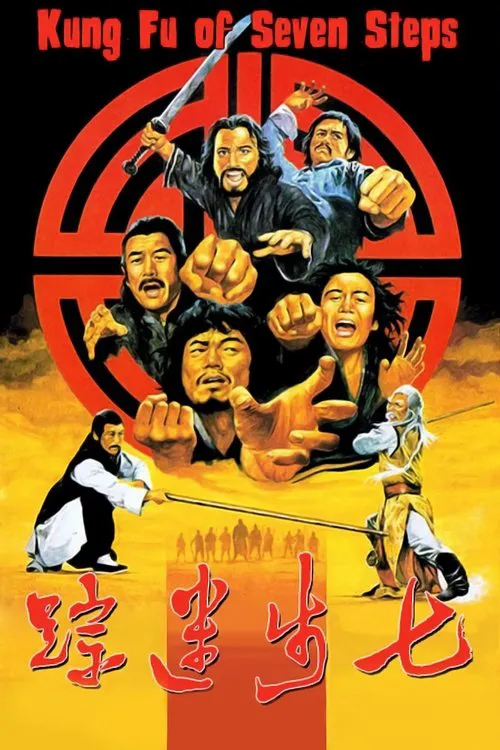Seven Steps of Kung Fu

Plot
In a small village nestled in the rolling hills of ancient China, a sense of unease settled over the residents as rumors began to circulate about a power-hungry general named Hsieh Tien. The general, known for his ruthlessness and cunning, had been secretly gathering a group of ruthless mercenaries and plotting to take over the peaceful village. As the people of the village went about their daily lives, unaware of the impending danger, a young local named Chia-Lung, also known as Tiger, stumbled upon the general's plans. Tiger, a skilled but still untested kung fu protege, realized the gravity of the situation and knew that he had to act quickly to save his village. With the fate of his community hanging in the balance, Tiger rushed to seek the wisdom and expertise of his wise and respected uncle, Kao Tsing. Kao Tsing, a seasoned master of the ancient and revered seven steps style of kung fu, was renowned throughout the region for his mastery of the intricate and powerful fighting art. The seven steps style, passed down through generations of Kao's family, had never been taught to anyone outside of the family lineage before, but Tiger begged his uncle to teach him the secrets of the style in order to defend their village against the general's men. Kao Tsing, with a deep understanding of the world's complexities and a keen insight into his nephew's potential, hesitated initially to teach Tiger the intricacies of the seven steps style. However, seeing the determination burning within his nephew, he relented, and began to instruct Tiger in the ancient art. Under Kao Tsing's patient and precise guidance, Tiger devoted himself to mastering the seven steps style. As he practiced tirelessly, he began to grasp the subtleties and complexities of the style, developing his skills and building his strength. The steps, though seemingly simple at first, required precision, focus, and a deep understanding of the body's movements. The seven steps themselves were not just physical movements but were also rooted in philosophy, strategy, and the harmony of yin and yang. Each step was designed to evoke a sense of balance and equilibrium within the practitioner, allowing them to move with fluidity and precision. Tiger threw himself into the training, pouring all his energy into mastering the style, and gradually, his movements became more fluid, his reflexes quicker, and his understanding of the art more profound. As the deadline for the village's takeover drew near, Tiger, now confident in his new skills, and his uncle, Kao Tsing, devised a plan to confront the general and his mercenaries. United in their determination to save their home, the uncle-and-nephew duo set out to engage the enemy, prepared to face whatever challenges lay ahead. Meanwhile, Hsieh Tien, the ruthless general, was growing increasingly impatient, and his men were itching to strike. Unbeknownst to the general, Tiger, having now mastered the seven steps style, was ready to unleash his newfound skills on the enemy. As the two forces clashed, the outcome was far from certain, and the villagers held their breath, waiting to see if their young hero would be able to save them from the jaws of destruction. As the battle between the general's men and Tiger unfolded, the air was filled with the sounds of clashing steel and the thunder of fist against fist. The seven steps style, with its emphasis on fluid movement and balance, seemed to give Tiger an uncanny edge against his opponents, leaving them stumbling to keep pace with his whirlwind attacks. However, the general and his lieutenants were not to be underestimated, and as the fight raged on, it became clear that the outcome would not be easily won. The air was filled with uncertainty as Tiger faced off against the general's most skilled warriors, but with the guidance of the seven steps style and the support of his family heritage, he pressed on, driven by a fierce determination to save his village. In the end, it was not just Tiger who fought bravely against the odds, but his uncle, Kao Tsing, who stood by his nephew, supporting him and teaching him the true meaning of the seven steps style. The general and his men were eventually repelled, and the village was safeguarded, thanks to the combined efforts of Tiger and Kao Tsing. As the villagers emerged from their homes to survey the aftermath of the battle, it was clear that Tiger's training in the seven steps style had saved them from a fate worse than death. Kao Tsing, wise and knowing, smiled at his nephew, acknowledging that Tiger had finally mastered the seven steps style and proved himself worthy of the ancient martial art. The young Tiger, his spirit bolstered by his triumph over the enemy, stood proudly, knowing that he had not only saved his village but had also earned his place as a master of the revered seven steps style. And so, as the villagers celebrated, the legacy of the seven steps style lived on through Tiger, a testament to the power and the value of the ancient art that had been passed down for generations.
Reviews
Recommendations




